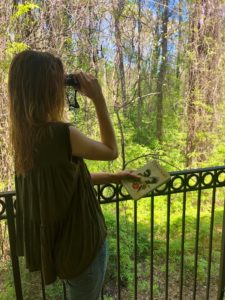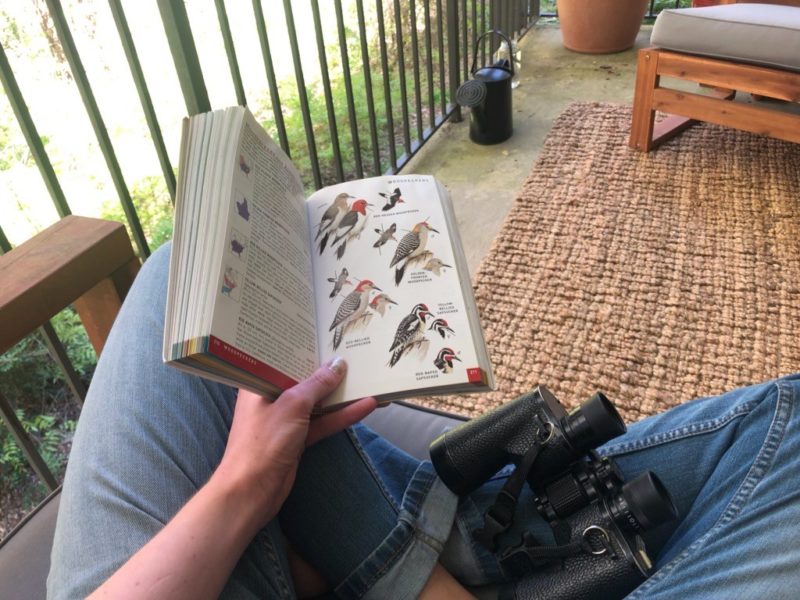Get started with birding
Backyard birding makes it easy to connect with nature
Written by Jana Pearce, Visitor Experience Manager
 With the onset of social distancing and working from home has come a hidden opportunity for us to reengage with old hobbies and discover new ones.
With the onset of social distancing and working from home has come a hidden opportunity for us to reengage with old hobbies and discover new ones.
I began birding as a way to spend time with my dad, who’s been at it for over 40 years and consistently blows me away with his mental lexicon of songs, markings, and bird behaviors. The sheer amount of natural history surrounding birds felt overwhelming at first, but the longer I observed, the more I began to connect with these creatures who can be hidden in plain sight. I realized that birding is about the journey, and that I should just focus on having fun and enjoying the glimpse into a world that can be mystifying, amusing, and even charming. The know-how will come over time!
Below are some tips on how you can get started at home:
Why birding?
 Birding can appeal to all sorts of people. Many like it because it helps them feel connected to nature, or to something larger than themselves. There are many popular community science projects that allow people to come together and make a difference in understanding and protecting birds. Check out more info at Atlanta Audubon’s Community Science page. Others like the prospect of creating a “life list” and seeing how many birds they can rack up over a life time.
Birding can appeal to all sorts of people. Many like it because it helps them feel connected to nature, or to something larger than themselves. There are many popular community science projects that allow people to come together and make a difference in understanding and protecting birds. Check out more info at Atlanta Audubon’s Community Science page. Others like the prospect of creating a “life list” and seeing how many birds they can rack up over a life time.
How do I attract bird to your backyard?
All living organisms need four things to be successful in their habitats: food, water, shelter, and space. You can provide food by setting up a bird feeder or planting your backyard with native, bird-attracting plants. To provide water, consider setting up a bird bath if there’s not a water source near your home. To provide shelter, you can install a bird box, or (again) do some planting. The more habitat types you have (bushes, tall trees, etc), the wider variety of species you’ll attract. Space simply means you’ll only attract so many birds to your backyard because it can only support so many (imagine an entire school of children trying to come have lunch in your kitchen!)
How do I clean and maintain my feeders?
 Be mindful that feeders can attract predators and spread disease if not placed well and maintained.
Be mindful that feeders can attract predators and spread disease if not placed well and maintained.
To protect from predators: try to place your feeder in a spot that has some protection from bird of prey who may be hunting from above. You’ll also want to monitor your feline friends if they’re allowed to be outside near your feeder.
Also consider placing your feeder away from windows, as birds often collide with them when all they can see is reflections of the surrounding flora.
To prevent the spread of disease: wash your feeder every two weeks, or at the very least between seasons. Start with soapy warm water, then use at 1:10 water bleach solution. Rinse thoroughly and allow to dry completely before refilling.
How do you identify the birds you see?
When birding, use your sense of sight, sound, and curiosity to help notice characteristics that will help you identify the bird.
- Distinctive markings – look for colors or patterns, like a solid white bar around the eye, or a “cap” of a certain color.
- Where is it? On the ground? At the tippy-top of a tree? Is it alone or in a group? This can often help you narrow down between possibilities.
- What’s it doing? Certain behaviors can be very characteristic of different types of birds. For example, phoebes are usually bobbing their tails.
- Songs and calls – close your eyes and try to focus on the sounds its making. This one can be tricky, but birding by ear can become a very valuable skill for a birder. Brush up on your songs, then test your skills while also helping the Cornell Lab of Ornithology improve their educational services.

